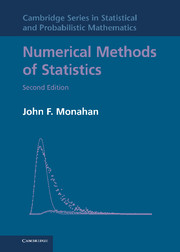Refine search
Actions for selected content:
2703 results in General statistics and probability
13 - Modelling time series
-
- Book:
- Financial Enterprise Risk Management
- Published online:
- 07 October 2011
- Print publication:
- 01 September 2011, pp 280-310
-
- Chapter
- Export citation
3 - Stakeholders
-
- Book:
- Financial Enterprise Risk Management
- Published online:
- 07 October 2011
- Print publication:
- 01 September 2011, pp 20-53
-
- Chapter
- Export citation
Index
-
- Book:
- Financial Enterprise Risk Management
- Published online:
- 07 October 2011
- Print publication:
- 01 September 2011, pp 540-551
-
- Chapter
- Export citation
Frontmatter
-
- Book:
- Measurement in Medicine
- Published online:
- 07 September 2011
- Print publication:
- 11 August 2011, pp i-iv
-
- Chapter
- Export citation
1 - Introduction
-
- Book:
- Measurement in Medicine
- Published online:
- 07 September 2011
- Print publication:
- 11 August 2011, pp 1-6
-
- Chapter
- Export citation
6 - Validity
-
- Book:
- Measurement in Medicine
- Published online:
- 07 September 2011
- Print publication:
- 11 August 2011, pp 150-201
-
- Chapter
- Export citation
9 - Systematic reviews of measurement properties
-
- Book:
- Measurement in Medicine
- Published online:
- 07 September 2011
- Print publication:
- 11 August 2011, pp 275-314
-
- Chapter
- Export citation
Preface
-
- Book:
- Measurement in Medicine
- Published online:
- 07 September 2011
- Print publication:
- 11 August 2011, pp ix-x
-
- Chapter
- Export citation
4 - Field-testing: item reduction and data structure
-
- Book:
- Measurement in Medicine
- Published online:
- 07 September 2011
- Print publication:
- 11 August 2011, pp 65-95
-
- Chapter
- Export citation
2 - Concepts, theories and models, and types of measurements
-
- Book:
- Measurement in Medicine
- Published online:
- 07 September 2011
- Print publication:
- 11 August 2011, pp 7-29
-
- Chapter
- Export citation
References
-
- Book:
- Measurement in Medicine
- Published online:
- 07 September 2011
- Print publication:
- 11 August 2011, pp 315-327
-
- Chapter
- Export citation
5 - Reliability
-
- Book:
- Measurement in Medicine
- Published online:
- 07 September 2011
- Print publication:
- 11 August 2011, pp 96-149
-
- Chapter
- Export citation
3 - Development of a measurement instrument
-
- Book:
- Measurement in Medicine
- Published online:
- 07 September 2011
- Print publication:
- 11 August 2011, pp 30-64
-
- Chapter
- Export citation
Contents
-
- Book:
- Measurement in Medicine
- Published online:
- 07 September 2011
- Print publication:
- 11 August 2011, pp v-viii
-
- Chapter
- Export citation
Index
-
- Book:
- Measurement in Medicine
- Published online:
- 07 September 2011
- Print publication:
- 11 August 2011, pp 328-338
-
- Chapter
- Export citation
7 - Responsiveness
-
- Book:
- Measurement in Medicine
- Published online:
- 07 September 2011
- Print publication:
- 11 August 2011, pp 202-226
-
- Chapter
- Export citation
8 - Interpretability
-
- Book:
- Measurement in Medicine
- Published online:
- 07 September 2011
- Print publication:
- 11 August 2011, pp 227-274
-
- Chapter
- Export citation

Numerical Methods of Statistics
-
- Published online:
- 01 June 2011
- Print publication:
- 18 April 2011
10 - Numerical Integration and Monte Carlo Methods
-
- Book:
- Numerical Methods of Statistics
- Published online:
- 01 June 2011
- Print publication:
- 18 April 2011, pp 257-302
-
- Chapter
- Export citation
9 - Maximum Likelihood and Nonlinear Regression
-
- Book:
- Numerical Methods of Statistics
- Published online:
- 01 June 2011
- Print publication:
- 18 April 2011, pp 219-256
-
- Chapter
- Export citation
